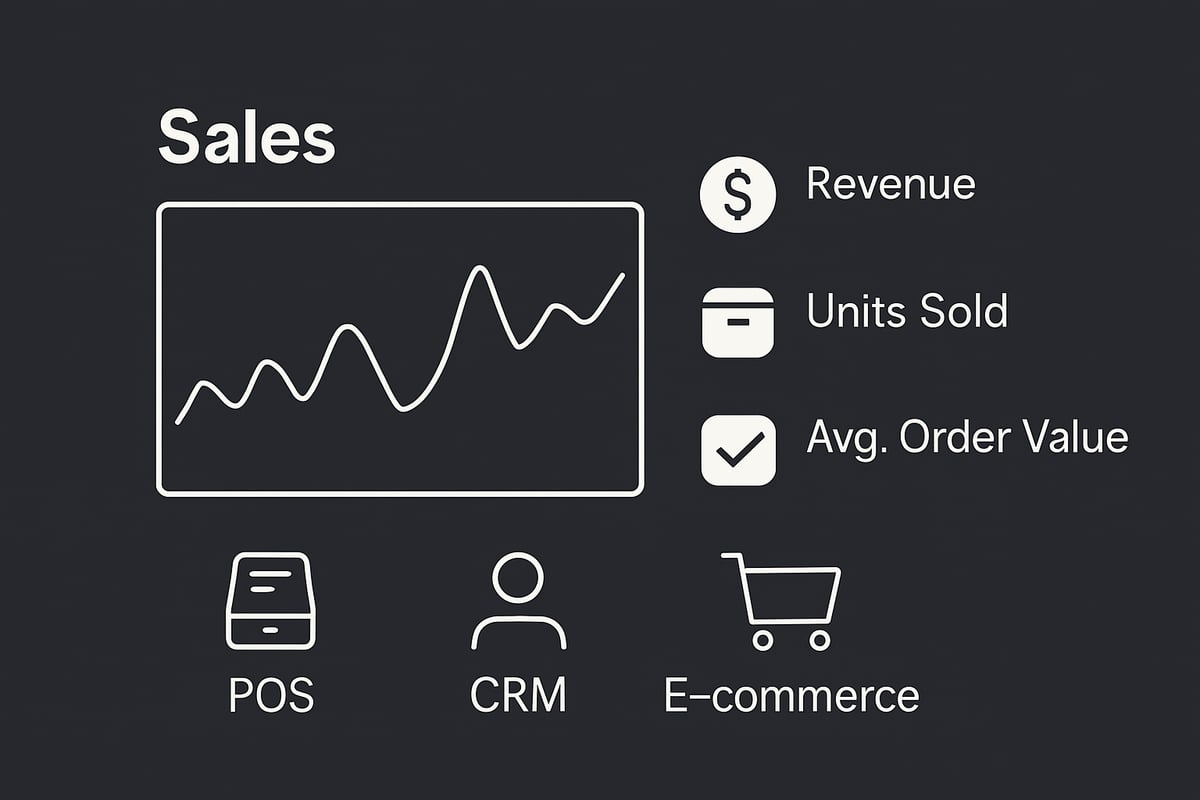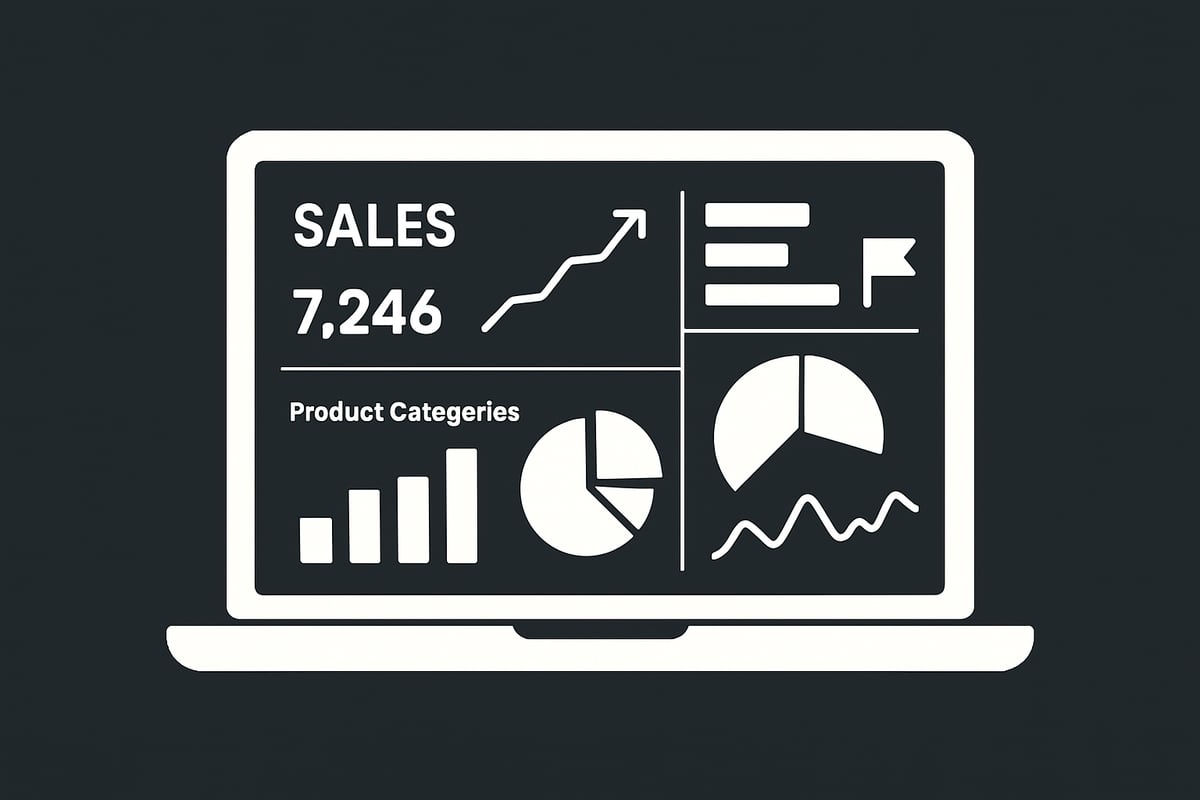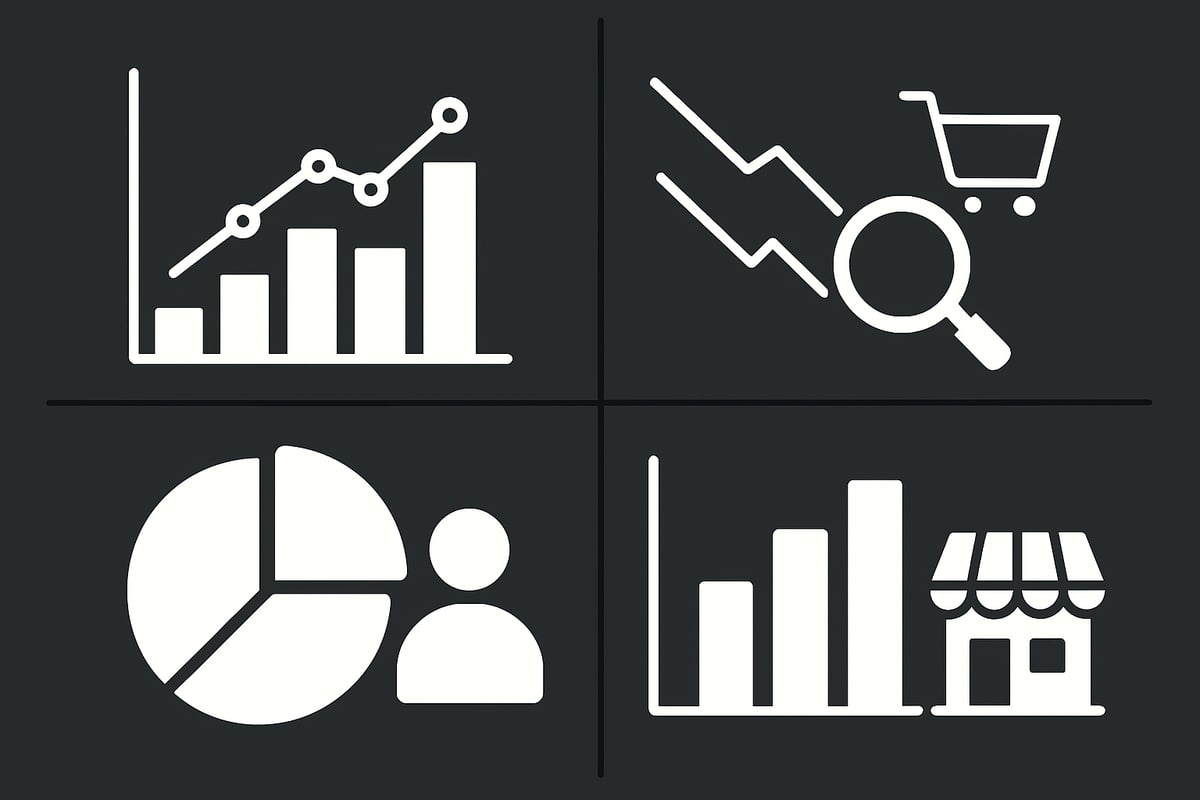Are you struggling to make sense of your sales numbers or wondering how to turn raw data into insights you can actually use? You’re not alone—many newcomers find sales data overwhelming at first.
This guide is here to demystify the process, offering a clear sales analysis example for beginners. You’ll learn how to interpret data, recognize trends, and make smarter business decisions in 2025’s fast-changing landscape.
Inside, we’ll break down core concepts, essential metrics, real-world scenarios, and provide a step-by-step walkthrough. Follow along to unlock the power of sales analysis and drive your business forward.
What is Sales Analysis?
Understanding the basics of sales analysis is the first step for any beginner looking to make sense of business performance. At its core, sales analysis is about transforming raw sales numbers into meaningful insights that drive results. Let’s break down what sales analysis means, its types, benefits, and how to overcome common challenges using today’s tools.

Definition and Purpose
Sales analysis is the process of systematically examining sales data to uncover trends, patterns, and opportunities for growth. By reviewing historical sales figures, businesses can make informed decisions, forecast demand, and fine-tune strategies for maximum impact.
The primary purpose of sales analysis is to provide clarity. Whether you’re in retail, e-commerce, or another industry, analyzing sales helps you spot what’s working and what isn’t. For instance, a sales analysis example might involve comparing monthly sales reports to identify seasonal peaks or dips. For a deeper dive into foundational concepts, visit Sales analysis fundamentals.
Types of Sales Analysis
There are four main types of sales analysis:
- Descriptive: Looks at what happened, such as last quarter’s total revenue.
- Diagnostic: Explores why something happened, like a sudden sales spike.
- Predictive: Forecasts what might happen using historical trends.
- Prescriptive: Recommends actions based on analysis.
A typical sales analysis example could involve using predictive analysis to estimate demand for a holiday season, helping you plan inventory and promotions ahead of time.
Key Benefits
A strong sales analysis example highlights how this process drives business growth. Key benefits include:
- Revenue Growth: Pinpoint bestsellers and optimize marketing.
- Inventory Management: Reduce overstock and prevent stockouts.
- Customer Targeting: Identify valuable segments for tailored campaigns.
According to industry studies, companies using sales analysis can achieve up to 30% higher sales efficiency. For example, a retailer implementing regular analysis saw a 20% reduction in stockouts, ensuring products were always available for customers.
Common Challenges for Beginners
Starting with sales analysis can seem overwhelming. Common challenges include:
- Data Overload: Too much information can cloud judgment.
- Lack of Analytical Skills: Interpreting data takes practice.
- Misinterpreting Results: Mistaking short-term spikes for lasting trends.
A classic sales analysis example is misreading a one-time sales surge as a long-term trend, leading to poor inventory decisions. Begin with simple reports and gradually build your confidence.
Tools and Technologies in 2025
Modern sales analysis is powered by accessible tools:
- Excel & Google Data Studio: Great for basic reporting.
- Power BI: Advanced visualization and integration.
- E-commerce Analytics: Shopify, WooCommerce, and others offer built-in insights.
AI and automation are making sales analysis easier than ever. For instance, an automated dashboard might flag a sudden drop in sales, providing a timely sales analysis example that demands immediate attention.
Key Sales Metrics and Data Sources
Understanding which numbers matter and where your data comes from is the foundation of any effective sales analysis example. For beginners, focusing on the right metrics and data sources makes the entire process less overwhelming and far more insightful.

Essential Sales Metrics to Track
When starting with any sales analysis example, focus on a handful of core metrics. These include revenue, units sold, average order value (AOV), conversion rate, customer acquisition cost, and retention rate. Each metric reveals a different aspect of your sales performance.
For instance, monitoring average order value helps you spot opportunities for bundling or upselling. Tracking units sold uncovers popular products, while retention rate shows how well you keep existing customers. By consistently reviewing these figures, you’ll notice trends and patterns that inform business decisions.
Data Sources for Sales Analysis
Reliable data sources are the backbone of any sales analysis example. Common sources include point-of-sale (POS) systems, e-commerce platforms, customer relationship management (CRM) tools, marketing platforms, and inventory management systems.
Integrating multiple sources gives a fuller picture. For example, merging CRM and sales data enables you to calculate customer lifetime value. Gathering data from both online and offline channels lets you compare performance across platforms. Always ensure your sources are up-to-date and easily accessible for smoother analysis.
Data Quality and Preparation
Clean, accurate data is essential for any sales analysis example. Data issues such as duplicates, missing values, or inconsistent formats can distort results and lead to poor business decisions.
Start by checking for missing SKUs or mismatched product names. Use data validation tools or spreadsheet functions to find and correct errors. Timeliness matters too—outdated data can cause you to react to trends that no longer exist. Regular audits and clear data entry guidelines help maintain the quality needed for meaningful analysis.
Visualizing Sales Data
Visualization transforms complex numbers in a sales analysis example into clear insights. Use charts, graphs, dashboards, and heatmaps to spot trends, patterns, and outliers quickly.
Line graphs are ideal for tracking sales over time, revealing growth or seasonal dips at a glance. Dashboards aggregate key metrics, making it easy to monitor performance in real time. Heatmaps can highlight high-performing products or regions. The right visuals make your findings actionable and easy to share with your team.
Real-World Data Example
Let’s look at a simple sales analysis example using a monthly sales dataset by product category. Imagine a table showing sales for electronics, apparel, and home goods over six months.
| Month | Electronics | Apparel | Home Goods |
|---|---|---|---|
| Jan | $12,000 | $8,000 | $5,000 |
| Feb | $13,500 | $7,500 | $5,500 |
| Mar | $15,000 | $9,000 | $6,200 |
From this, you can identify electronics as a consistent top performer and spot months where apparel lags. This approach helps you focus your efforts and resources where they matter most in your sales analysis example.
Step-by-Step Sales Analysis Example for Beginners
Sales analysis can seem overwhelming, but breaking it down into clear steps makes it manageable for any beginner. This step-by-step sales analysis example will walk you through the entire process, from setting your goal to monitoring results. By following these practical steps, you’ll gain confidence in making data-driven decisions using your own sales data.

Step 1: Define Your Sales Analysis Goal
Start your journey by clarifying what you want to achieve. Every strong sales analysis example begins with a specific objective. Are you aiming to boost overall revenue, reduce customer churn, or optimize your product offerings?
Let’s say your goal is to identify products with declining sales. By narrowing your focus, you ensure that your analysis remains actionable and relevant. Write down your goal and keep it visible throughout the process. This clarity will guide your data collection and help you choose the right metrics later.
Step 2: Gather and Prepare Your Data
Next, collect the data you’ll need. For any effective sales analysis example, accurate and comprehensive data is crucial. Start by exporting sales reports from your e-commerce platform, POS system, or CRM.
Once you have your data, clean it thoroughly. Remove duplicates, check for missing values, and ensure consistent formatting. For instance, exporting sales data from Shopify often requires reviewing SKUs and customer details for accuracy. Good preparation prevents misleading outcomes and sets a solid foundation for analysis.
Step 3: Choose Your Metrics and KPIs
With your goal and clean data in hand, select the metrics that matter most. A practical sales analysis example focuses on metrics like units sold, average order value, and customer retention rate, depending on your objective.
Suppose you’re exploring bundling opportunities. You might track units sold and average order value to spot trends in product combinations. Choosing relevant KPIs aligns your analysis with your business goals and supports better decision-making. Avoid tracking too many metrics, as this can dilute your focus and slow progress.
Step 4: Analyze Trends and Patterns
Now, dive into the numbers. Look for patterns, spikes, and dips over time. A strong sales analysis example uses tools like line graphs, moving averages, and year-over-year comparisons to uncover trends.
For example, you might notice a recurring sales boost each summer. By visualizing your data, you can quickly identify seasonality or unexpected changes. Regularly reviewing these trends helps you adapt your strategies, such as planning promotions around peak periods to maximize impact.
Step 5: Segment Your Data
Segmentation gives depth to your sales analysis example by breaking down results by product, region, customer type, or sales channel. This step reveals hidden opportunities and challenges that aggregate data can mask.
Suppose you segment sales by product category and discover that accessories outperform main products in a specific region. For more on how to approach this, check out Product analysis for sales insights. Segmentation helps you tailor your marketing and inventory strategies, ensuring resources go where they’re most effective.
Step 6: Draw Actionable Insights
Turn your findings into concrete actions. A compelling sales analysis example doesn’t stop at observation; it recommends specific next steps. If you notice slow-moving inventory, consider bundling these items with bestsellers or offering targeted discounts.
For instance, after segmenting your data, you might decide to launch a promotion pairing low-performing products with your top sellers. Document your recommendations and prioritize them based on potential impact and feasibility. Actionable insights bridge the gap between analysis and real business results.
Step 7: Implement and Monitor Changes
Finally, put your insights into practice and track the outcomes. The best sales analysis example includes follow-up to measure the effectiveness of your actions. Did your new product bundle increase average order value? Are sales in the targeted region rising?
Set up regular check-ins to review performance. Use automated dashboards to monitor key metrics and adjust your approach as needed. Continuous improvement is at the heart of successful sales analysis, ensuring your business stays agile and growth-focused.
Practical Sales Analysis Examples and Case Studies
Unlocking the value of sales data starts with seeing real-world applications. Below are four practical sales analysis example scenarios that beginners can use as blueprints. Each example demonstrates how structured analysis can reveal actionable insights and drive business growth.

Example 1: Identifying Top-Selling Products
A classic sales analysis example involves pinpointing your best-performing products. Start by compiling a table of monthly sales by SKU or category. Sort the data to highlight the highest revenue generators.
- Step 1: Gather sales data for all products over the last quarter.
- Step 2: Rank products by total units sold and revenue.
- Step 3: Focus marketing campaigns on the top three performers.
For instance, an electronics retailer used this approach. By reallocating ad spend to their top three products, they achieved a 15% sales boost. This sales analysis example helps prioritize resources for maximum impact.
Example 2: Detecting Sales Declines Early
Another sales analysis example is trend analysis to spot issues before they hit your bottom line. Pull monthly sales for each category and plot them on a line graph. Look for downward trends.
- Step 1: Chart category sales over time.
- Step 2: Identify significant drops or stagnation.
- Step 3: Investigate underlying causes, such as outdated inventory or shifting customer preferences.
A clothing store noticed a steady decline in women's outerwear. By pivoting to new styles and promoting them, they reversed the trend. This proactive sales analysis example prevents prolonged revenue loss.
Example 3: Customer Segmentation for Targeted Campaigns
Segmenting customers is a powerful sales analysis example. Export sales data along with customer demographics from your CRM. Group buyers by age, location, or purchase frequency.
- Step 1: Analyze total sales by demographic segment.
- Step 2: Identify underserved or high-potential groups.
- Step 3: Tailor marketing campaigns to specific segments.
For example, a retailer discovered younger shoppers were underrepresented. They launched campaigns tailored to this group and saw new customer growth. For more on how sales data drives marketing strategy, see the Role of sales data in marketing.
Example 4: Channel Performance Comparison
Comparing channels is a valuable sales analysis example for multi-platform businesses. Collect sales data from in-store, online, and third-party platforms. Use a table to contrast results.
| Channel | Sales (Jan–Mar) | % Growth |
|---|---|---|
| In-Store | $120,000 | 2% |
| Online | $180,000 | 10% |
| Delivery Apps | $200,000 | 15% |
A restaurant chain discovered delivery sales overtook dine-in during promotions. This sales analysis example revealed where to focus marketing and operational efforts for higher returns.
Common Mistakes to Avoid in Sales Analysis
When working with any sales analysis example, even experienced teams can fall into common traps. Recognizing these mistakes early helps you build a foundation for accurate, actionable insights. Let’s break down the biggest pitfalls beginners face so you can sidestep them as you interpret your own sales analysis example.
Overlooking Data Quality Issues
Data quality is the backbone of every sales analysis example. If your data is outdated, incomplete, or inconsistent, your conclusions will be unreliable. Imagine making inventory decisions based on duplicate sales records or missing product codes—this leads to overstocking or missed opportunities.
Common data issues include:
- Duplicate entries
- Missing values
- Inconsistent formats
To avoid these mistakes, always audit your data before analysis. For a deeper dive into maintaining high data standards, review the Sales Analytics Best Practices for 2025.
Misinterpreting Correlation and Causation
A frequent mistake in a sales analysis example is assuming that two events happening together means one caused the other. For instance, if a sales spike aligns with a new marketing campaign, it’s tempting to credit the campaign without further evidence.
Remember:
- Correlation does not equal causation
- Analyze supporting factors before drawing conclusions
Always look for additional data or controlled comparisons before making business decisions. This prevents you from acting on misleading insights and ensures your strategies are truly effective.
Ignoring External Factors
External influences can dramatically affect the outcome of any sales analysis example. Seasonality, economic shifts, or competitor actions may drive changes in your numbers that have nothing to do with your internal operations.
Key external factors include:
- Seasonal demand swings
- Market trends
- New competition
If sales dip, don’t assume it’s due to internal issues alone. Check for broader market changes or external disruptions that might explain the results you see in your sales analysis example.
Failing to Take Action on Insights
The true value of a sales analysis example lies in the actions you take. Too often, businesses identify opportunities or problems, then fail to implement changes. For instance, you might spot a chance for cross-selling but never update your promotions or store layout.
To avoid this, create a clear plan for acting on your findings. Set measurable targets and follow up on results. For more strategies on turning analysis into action, see this Sales Analysis Guide: Strategies and Best Practices for 2025.
Tips and Best Practices for Effective Sales Analysis in 2025
Staying ahead in sales analysis example work requires a blend of technology, discipline, and teamwork. In 2025, effective analysis is about working smarter, not just harder. These best practices will help you unlock deeper insights and drive real business results.
Leverage Automation and AI Tools
Harnessing automation and AI is essential for any modern sales analysis example. Today’s tools can process huge volumes of sales data in seconds, spot trends you might miss, and even provide proactive recommendations. Automated dashboards send alerts about unusual activity, helping you react quickly.
For beginners, this means less time spent on manual data crunching and more focus on interpreting results. AI tools can flag outliers, predict future sales, and uncover hidden patterns. To explore the latest options, check out the Best Sales Automation Tools: How Smart Teams Close 30% More Deals Without Working Harder, which highlights how automation boosts efficiency.
When choosing tools, prioritize those that integrate with your existing systems and offer user-friendly interfaces. Start with simple automation to build confidence before exploring advanced AI features.
Start Simple and Scale Up
A successful sales analysis example begins with mastering the basics. Focus on core metrics like revenue and units sold. Once you’re comfortable, gradually introduce more advanced analytics, such as customer segmentation or predictive modeling.
Here’s a practical approach:
- Track basic metrics first.
- Visualize data with simple charts.
- Set regular review intervals.
- Add complexity only as your skills grow.
This incremental strategy prevents overwhelm and builds a strong analytical foundation. Remember, even seasoned professionals started with the basics. By scaling your approach thoughtfully, you’ll avoid common pitfalls and gain lasting confidence in your analysis.
Regularly Review and Update Analysis
Consistency is key to any sales analysis example. Schedule regular analysis sessions—monthly or quarterly—to review recent performance and adjust strategies. This routine helps you spot trends, evaluate previous decisions, and respond promptly to market changes.
During each session, revisit your goals and key metrics. Ask yourself: Are you meeting targets? Have new opportunities or challenges emerged? Use dashboards and reports to keep data accessible and actionable.
Establishing a review habit ensures your analysis stays relevant and drives continuous improvement. Over time, you’ll notice patterns and gain a deeper understanding of your business dynamics.
Collaborate Across Teams
Collaboration amplifies the value of any sales analysis example. Include sales, marketing, and operations in your analysis process. Each team brings unique insights, leading to more robust interpretations and better decisions.
For example, marketing can explain campaign impacts, while operations highlight supply chain constraints. Regular cross-functional meetings foster open dialogue and shared ownership of results.
Consider creating shared dashboards or reports so all stakeholders stay informed. This unified approach breaks down silos, accelerates action, and ensures your analysis translates into impactful business changes.